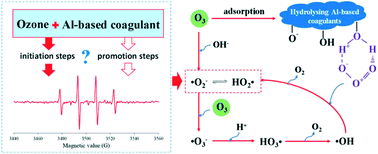Role of Al-based coagulants on a hybrid ozonation–coagulation (HOC) process for WWTP effluent organic matter and ibuprofen removal†
Abstract
The removal performance of a hybrid ozonation–coagulation (HOC) process using AlCl3·6H2O for wastewater treatment plant (WWTP) effluent organics and ibuprofen (IBP) removal is investigated. The HOC process exhibited a higher removal efficiency than coagulation and conventional pre-ozonation coagulation processes. Electron paramagnetic resonance (EPR) analysis in both ultrapure water and WWTP effluent indicated that more hydroxyl radicals (˙OH) were generated in the HOC process than in the ozonation process. The ˙OH yields, both with and without a promotion step of chain reactions, were compared for ultrapure water and WWTP effluent using tert-butanol (tBuOH) assay and the competition method. A comparison revealed that the Al-based coagulants acted more like promoters for the generation of ˙O2− to propagate the ˙OH chain reactions rather than as initiators in the HOC process for ˙OH generation. Furthermore, initiation and promotion rate constants for the Al-based coagulants were calculated to support the results obtained from the ˙OH yield experiments. The illustration of the behavior of Al-based coagulants in the HOC process provides a theoretical foundation for the application of the HOC process in advanced water/wastewater treatment.



 Please wait while we load your content...
Please wait while we load your content...